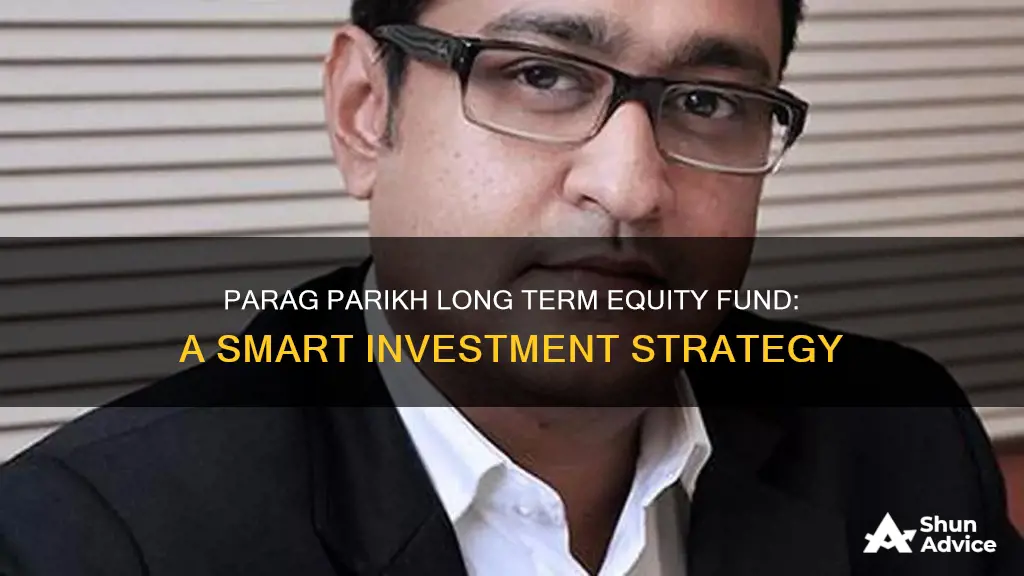
Parag Parikh Flexi Cap Fund is a mutual fund scheme from PPFAS Mutual Fund. The fund aims to achieve long-term capital appreciation by investing primarily in equity and equity-related instruments. It has no lock-in period and can be purchased directly from the PPFAS Mutual Fund website or through platforms like MF Central and MF Utility. The fund has a very high risk rating and investors must be prepared for ups and downs in their investment value.
| Characteristics | Values |
|---|---|
| Risk | Very High |
| Investment Objective | To achieve long-term capital appreciation by investing primarily in equity and equity-related instruments |
| Investment Amount | Minimum SIP Investment: ₹1,000; Minimum Lumpsum Investment: ₹1,000 |
| NAV | ₹87.43 as of 10 Oct 2024 |
| AUM | ₹82,441 Crore as of 30 Sep 2024 |
| Returns | 38.40% in the last 1 year; 20.99% average annual returns since inception |
| Expense Ratio | 0.63% |
| Exit Load | For units above 10% of the investment, exit load of 2% if redeemed within 365 days and 1% if redeemed after 365 days but on or before 730 days |
| Capital Gains Taxation | If units are sold after 1 year from the date of investment, gains up to Rs 1.25 lakh in a financial year are exempt from tax. Gains over Rs 1.25 lakh are taxed at 12.5%. If units are sold within 1 year, the entire amount of gain is taxed at 20% |
| Dividends | Added to the income of the investors and taxed according to their respective tax slabs. If an investor's dividend income exceeds Rs. 5,000 in a financial year, a TDS of 10% is deducted before distribution |
What You'll Learn

Understanding the fund's investment objective
The Parag Parikh Flexi Cap Fund is a mutual fund scheme that aims to achieve long-term capital appreciation by primarily investing in equity and equity-related instruments. This fund is suitable for investors who are looking to invest money for at least three to four years and are seeking high returns, while also being prepared for the possibility of moderate losses.
As a flexi-cap fund, the management team has complete freedom to invest in companies of different sizes, depending on where they expect maximum gains. This versatility makes flexi-cap funds particularly suitable for equity fund investors, as the responsibility of stock selection is left entirely to the fund manager.
The fund has a very high risk rating and investors must be prepared for ups and downs in their investment value. It is recommended that investors only consider this fund if they can remain invested for at least five years.
The fund has delivered average annual returns of 20.99% since its inception and has doubled the money invested every four years. The fund's top holdings include investments in Power Grid Corporation of India Ltd., Bajaj Holdings & Investment Ltd., and Maruti Suzuki India Ltd.
Index Funds: A Beginner's Guide to Investing
You may want to see also

Analysing the fund's historical performance
Analysing the historical performance of the Parag Parikh Flexi Cap Fund involves evaluating various factors, including returns, rankings, asset allocation, risk, and portfolio composition. Here is a detailed analysis of the fund's historical performance:
Returns and Rankings:
The Parag Parikh Flexi Cap Fund has delivered competitive returns since its inception on May 13, 2013. As of October 10, 2024, the fund's Net Asset Value (NAV) was ₹87.43, with a 1-day change of +0.54%. The fund has generated average annual returns of 20.99% since its launch, doubling the invested money every 4 years. The returns for the last 1 year were 38.40%, and the fund has an absolute return of 52.69%. In terms of rankings, the fund has a consistency rating of 4.5 and an ET Money Rank of #1 of 23 in its category.
Asset Allocation:
As of September 30, 2024, the fund's asset allocation was primarily in equity (81.27%), followed by debt (18.08%), and other holdings (0.65%). Within the equity allocation, the fund invested in foreign equity (12.41%) and certificate of deposit (3.44%).
Risk and Return Analysis:
The Parag Parikh Flexi Cap Fund has a risk rating of "Very High" according to SEBI's Riskometer. The fund has a volatility rating of 4 out of 7, indicating a relatively stable performance. The fund's standard deviation, a measure of volatility, is lower than that of its peers, suggesting more predictable returns. The fund has a beta value lower than its peers, indicating less sensitivity to market changes. The Sharpe ratio, Treynor's ratio, and alpha are all favourable, indicating better risk-adjusted returns and excess returns relative to the benchmark.
Portfolio Composition:
The fund has invested the majority of its assets in the Financial, Services, Technology, Energy, and Automobile sectors. The top holdings include Power Grid Corporation of India Ltd., Bajaj Holdings & Investment Ltd., ITC Ltd., Coal India Ltd., and Maruti Suzuki India Ltd. The fund holds 56 stocks in total, with a mix of Large Cap (50.53%), Mid Cap (3.79%), and Small Cap (6.29%) investments.
HOA Fund Investment Strategies: A Guide to Smart Investing
You may want to see also

Evaluating the fund's risk and return profile
When evaluating the risk and return profile of the Parag Parikh Flexi Cap Fund, it's important to consider several key factors. Firstly, the fund has a very high-risk rating according to SEBI's Riskometer. This indicates that investors need to be prepared for potential ups and downs in their investment value. The fund aims to achieve long-term capital appreciation by primarily investing in equity and equity-related instruments.
One of the advantages of this fund is its flexibility. As a flexi-cap fund, the fund management team has complete freedom to invest in companies of different sizes, depending on where they expect maximum gains. This versatility makes it a suitable choice for equity fund investors who want to leave the stock selection to the fund manager. However, investors should be aware that this fund comes with a warning: do not invest if you need to redeem your investment in less than five years.
In terms of returns, the Parag Parikh Flexi Cap Fund has delivered average annual returns of 20.99% since its inception. It has doubled the money invested every four years. When compared to other funds in its category, this fund has generated the highest return over the last ten years. For every unit of risk, this fund produces 20% more returns. It has a return consistency rating of 4.5, indicating that it has not generated exceptionally high returns and that these returns are not very consistent.
The fund's top sectors for investment include Financial, Services, Technology, Energy, and Automobile. Its top holdings include Power Grid Corporation of India Ltd., Bajaj Holdings & Investment Ltd., Maruti Suzuki India Ltd., and HCL Technologies Ltd.
When considering the risk and return profile, investors should also be mindful of the expenses associated with the fund. The expense ratio of the direct plan is 0.63%, which is close to what most other Flexi Cap funds charge. Additionally, there is an exit load of 2% if redeemed within 365 days and 1% if redeemed after 365 days but before 730 days.
Unlocking Private Equity: The Power of Fund of Funds
You may want to see also

Considering the fund's asset allocation and sector focus
The fund's top holdings include well-known Indian companies such as Power Grid Corporation of India Ltd., Bajaj Holdings & Investment Ltd., Maruti Suzuki India Ltd., and HCL Technologies Ltd. The fund's sector focus includes financial, services, technology, energy, and automobile sectors.
The fund's objective is to achieve long-term capital appreciation by primarily investing in equity and equity-related instruments. It offers investors the potential for strong returns, outperforming its category peers in terms of consistency of returns and protection from volatility.
The fund carries a high level of risk and is suitable for investors who are comfortable with a high level of risk and volatility and are seeking high returns over a period of at least 3-4 years.
Small-Cap Growth Funds: Smart Investment, Big Returns
You may want to see also

Reviewing the fund's tax implications
Parag Parikh Flexi Cap Fund is a mutual fund scheme that aims to achieve long-term capital appreciation by investing primarily in equity and equity-related instruments. The fund offers both growth and dividend options, with the ability to invest through a Systematic Investment Plan (SIP). While investing in this fund, it is important to consider its tax implications, which can impact your overall returns. Here is a review of the fund's tax implications:
Short-Term Capital Gains Tax:
If an investor chooses to redeem their mutual fund units within one year from the date of investment, the entire amount of gain is subject to a short-term capital gains tax. The current short-term capital gains tax rate is 20% of the total gain. This rate applies to all equity-oriented mutual funds, including Parag Parikh Flexi Cap Fund. It is important to note that short-term capital gains are added to the investor's income and taxed according to their respective tax slabs.
Long-Term Capital Gains Tax:
On the other hand, if an investor redeems their mutual fund units after holding them for more than one year, long-term capital gains tax comes into effect. The current long-term capital gains tax rate is 12.5% on gains exceeding Rs. 1.25 lakh in a financial year. It is important to note that long-term capital gains up to Rs. 1.25 lakh in a financial year are exempt from tax.
Dividend Distribution Tax:
When an investor chooses the dividend option, the dividends received are subject to dividend distribution tax (DDT). The DDT rate for equity-oriented mutual funds is currently set at 10%. This tax is deducted by the fund house before distributing the dividend to the investor.
Tax Deducted at Source (TDS):
If an investor's dividend income from mutual funds exceeds Rs. 5,000 in a financial year, the fund house is required to deduct TDS at a rate of 10% before distributing the dividend. This TDS is applicable in addition to the DDT mentioned above.
Exit Load:
The Parag Parikh Flexi Cap Fund also has an exit load, which is a fee charged when investors redeem their units. The exit load for this fund is 2% if the units are redeemed within 365 days and 1% if redeemed after 365 days but on or before 730 days. It is important to note that the exit load is applicable for units above 10% of the investment.
In conclusion, while investing in the Parag Parikh Flexi Cap Fund, investors should carefully consider the tax implications outlined above. These taxes and fees can impact the overall returns generated from the investment. It is always advisable to consult a financial advisor or tax expert to understand how these taxes may apply to your specific investment situation.
Best HDFC Mutual Funds: Where to Invest Smartly
You may want to see also
Frequently asked questions
Parag Parikh Flexi Cap Fund is a mutual fund scheme launched by PPFAS Mutual Fund on 10 October 2012. It aims to achieve long-term capital appreciation by investing primarily in equity and equity-related instruments.
You can invest in Parag Parikh Flexi Cap Fund directly from the PPFAS Mutual Fund website or through platforms like MF Central and MF Utility. You can also seek help from a mutual fund distributor or your bank.
The minimum SIP investment is ₹1,000, and the minimum lumpsum investment is also ₹1,000.
The NAV or Net Asset Value of Parag Parikh Flexi Cap Fund as of 10 October 2024 is ₹87.43.
The expense ratio of Parag Parikh Flexi Cap Fund is 0.63%. This is the annual fee charged by the fund for managing your investment.







